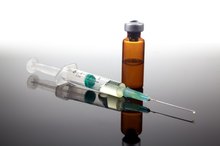What does fact checked mean?
At Healthfully, we strive to deliver objective content that is accurate and up-to-date. Our team periodically reviews articles in order to ensure content quality. The sources cited below consist of evidence from peer-reviewed journals, prominent medical organizations, academic associations, and government data.
The information contained on this site is for informational purposes only, and should not be used as a substitute for the advice of a professional health care provider. Please check with the appropriate physician regarding health questions and concerns. Although we strive to deliver accurate and up-to-date information, no guarantee to that effect is made.
What Are the Treatments for an Arm Blood Clot?
A blood clot, or deep venous thrombosis, is the formation of a hardened blood in a blood vessel 1. Although DVTs most commonly occur in the legs, they may also occur in the arms, particularly if the patient recently had arm surgery. A DVT is concerning because the blood clot can break off and get stuck in the brain, lungs, heart or other areas of the body, states MedlinePlus, a service of the National Institutes of Health. Therefore prompt treatment of a blood clot is necessary to prevent further complications.
If you are experiencing serious medical symptoms, seek emergency treatment immediately.
Heparin
A patient with a suspected blood clot in the arm should seek medical treatment. Once a patient gets to the hospital the doctor will perform a history and physical exam to determine the likelihood of a blood clot in the arm. If suspicions are high, the physician will prescribe heparin, which is given through a vein, or intravenously. In this case a patient must stay in the hospital until the doctor has determined that the blood has thinned to an appropriate level. If a doctor suspects other blood clots may form, he may prescribe warfarin. However, warfarin takes a few days to take effect; therefore, heparin will be continued until the appropriate levels of warfarin are reached.
- A patient with a suspected blood clot in the arm should seek medical treatment.
- If a doctor suspects other blood clots may form, he may prescribe warfarin.
Warfarin
Plavix & Fish Oil
Learn More
MedlinePlus states that warfarin is a medication that can be taken by mouth to thin the blood. This medication takes several days to work, and in some cases, it may be taken for the rest of a patient’s life to prevent blood clots. If the blood clot in the arm is an isolated episode, a patient may only need to take warfarin for three months. This medication is beneficial in preventing blood clots; however, it can make a patient more likely to bleed if he experiences a cut or an internal injury that involves internal bleeding. Therefore, a patient should seek immediate medical attention if he is experiencing uncontrolled bleeding or is at risk for internal bleeding from trauma.
- MedlinePlus states that warfarin is a medication that can be taken by mouth to thin the blood.
- This medication is beneficial in preventing blood clots; however, it can make a patient more likely to bleed if he experiences a cut or an internal injury that involves internal bleeding.
Clotbusters
MayoClinic.com states that clot busters may be used to treat a blood clot in the arm. This type of treatment is reserved for more serious types of blood clots that are at risk for traveling to the lungs or to other organs. Clot busters are known as thrombolytics and are given through a vein to break up blood clots. Clot busters may be beneficial, but they may cause serious bleeding that cannot be stopped. These medications are reserved for life-threatening situations, states MayoClinic.com.
- MayoClinic.com states that clot busters may be used to treat a blood clot in the arm.
Related Articles
References
- Medline Plus: Deep Vein Thrombosis
- MayoClinic.com: Deep Vein Thrombosis
- National Heart Lung and Blood Institute. Venous thromboembolism.
- National Blood Clot Alliance. Blood Clot Treatment.
Writer Bio
As a physical medicine and rehabilitation physician I have extensive experience in musculoskeletal/neurological medicine that will benefit the network.









